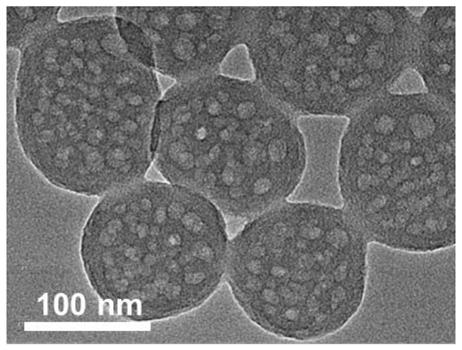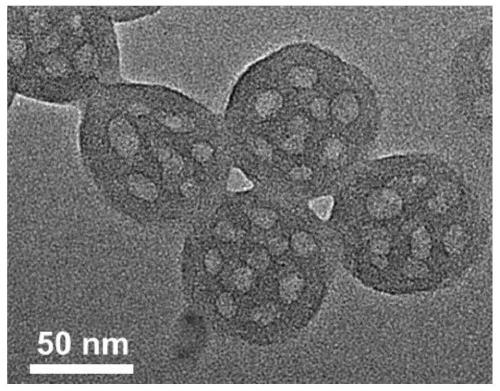Preparation of multi-cavity carbon spheres by a self-assembly method driven by surface energy and its application
A self-assembly and cavity technology, applied in the preparation/purification of carbon, nano-carbon, nanotechnology, etc., can solve the problem that microfluidic technology is difficult to produce large quantities of products
- Summary
- Abstract
- Description
- Claims
- Application Information
AI Technical Summary
Problems solved by technology
Method used
Image
Examples
Embodiment 1
[0031] Weigh 100mg of surfactant F127, add it into 10ml of deionized water, stir and dissolve at 40°C for 2h. Dissolve 50 mg of stearic acid in 0.5 mL of n-hexane, pour it into an aqueous solution of surfactant, and sonicate for 30 min to obtain a translucent white emulsion. Distill under reduced pressure at 50°C for 0.5h to remove n-hexane in the emulsion to obtain solution A. Weigh 275mg resorcinol, 210mg hexamethylenetetramine, 90ml deionized water, stir well at 40°C, add solution A, stir slowly and mix well to obtain solution B. The reaction solution B was transferred to a hydrothermal kettle, and hydrothermally reacted at 110°C for 4 hours to obtain a monodisperse multi-cavity polymer colloid solution C, which was centrifuged, washed with water and ethanol, and dried to obtain a dry multi-cavity polymer.
Embodiment 2
[0033] The multi-cavity polymer prepared in Example 1 was placed in a carbonization furnace for carbonization, protected by argon at 3°C / min to 150°C, kept at a constant temperature for 120min, and then raised to a carbonization temperature of 600°C at a heating rate of 5°C / min. Constant temperature for 120min, carbonization to obtain multi-cavity carbon spheres with shape retention.
[0034] The cavity size of multi-cavity carbon spheres obtained in this embodiment is 12 ± 2nm, the number of cavities is 40 ± 5, and the diameter of carbon spheres is 105 ± 10nm. The transmission electron microscope shows figure 1 shown.
Embodiment 3
[0036]Take 50ml of solution B in Example 1, add 50ml of deionized water, mix and stir evenly, transfer the obtained solution into a hydrothermal kettle, and perform a hydrothermal reaction at 110°C for 4h to obtain a monodisperse multi-cavity polymer colloid solution. Centrifuge, wash with water and ethanol, and dry to obtain a dry multi-cavity polymer. The multi-cavity polymer prepared in this example was placed in a carbonization furnace for carbonization, and the method was the same as in Example 2 to obtain multi-cavity carbon spheres.
[0037] The cavity size of multi-cavity carbon spheres obtained in this embodiment is 12 ± 2nm, the number of cavities is 10 ± 2, and the diameter of carbon spheres is 70 ± 5nm. The transmission electron microscope shows figure 2 shown.
PUM
| Property | Measurement | Unit |
|---|---|---|
| thickness | aaaaa | aaaaa |
| diameter | aaaaa | aaaaa |
| diameter | aaaaa | aaaaa |
Abstract
Description
Claims
Application Information
 Login to View More
Login to View More - R&D
- Intellectual Property
- Life Sciences
- Materials
- Tech Scout
- Unparalleled Data Quality
- Higher Quality Content
- 60% Fewer Hallucinations
Browse by: Latest US Patents, China's latest patents, Technical Efficacy Thesaurus, Application Domain, Technology Topic, Popular Technical Reports.
© 2025 PatSnap. All rights reserved.Legal|Privacy policy|Modern Slavery Act Transparency Statement|Sitemap|About US| Contact US: help@patsnap.com



